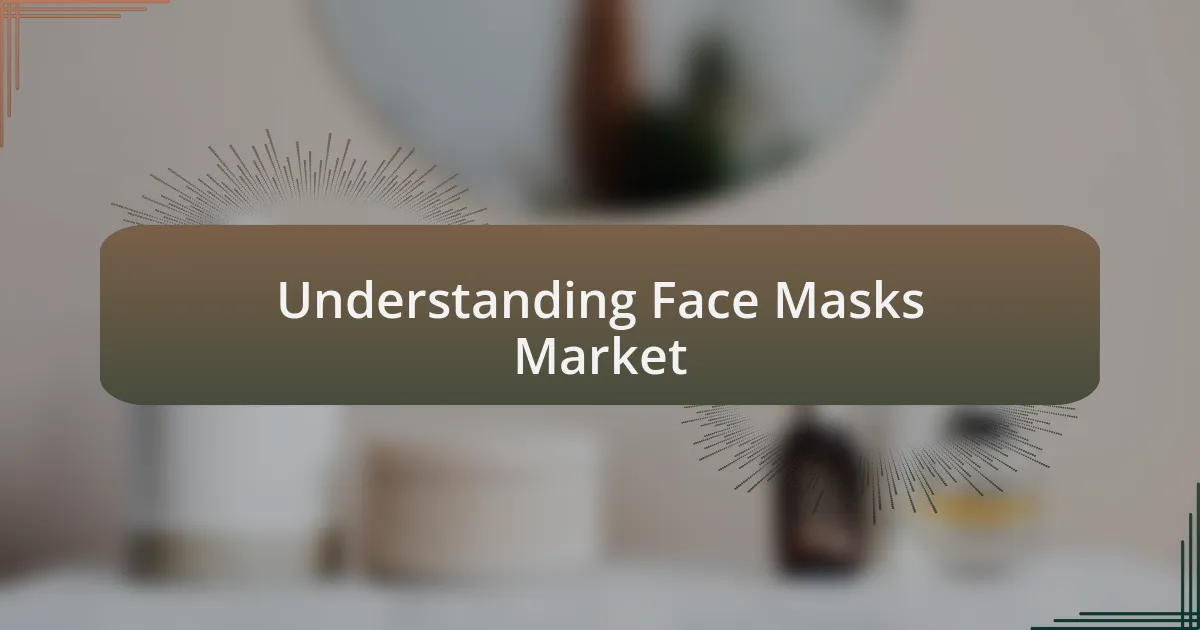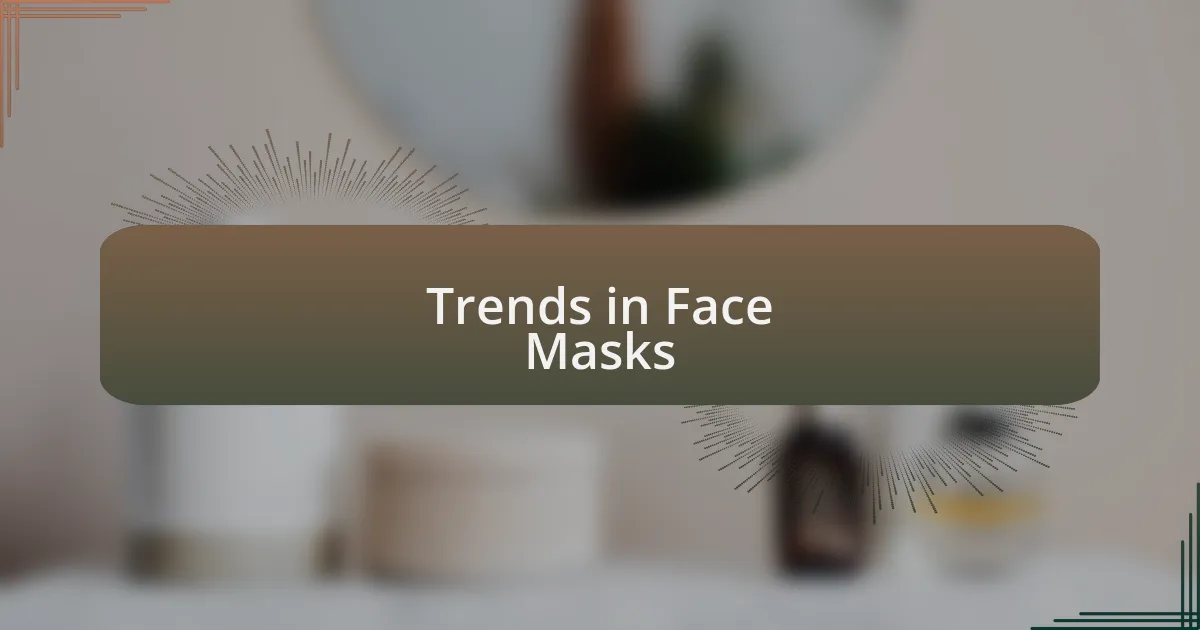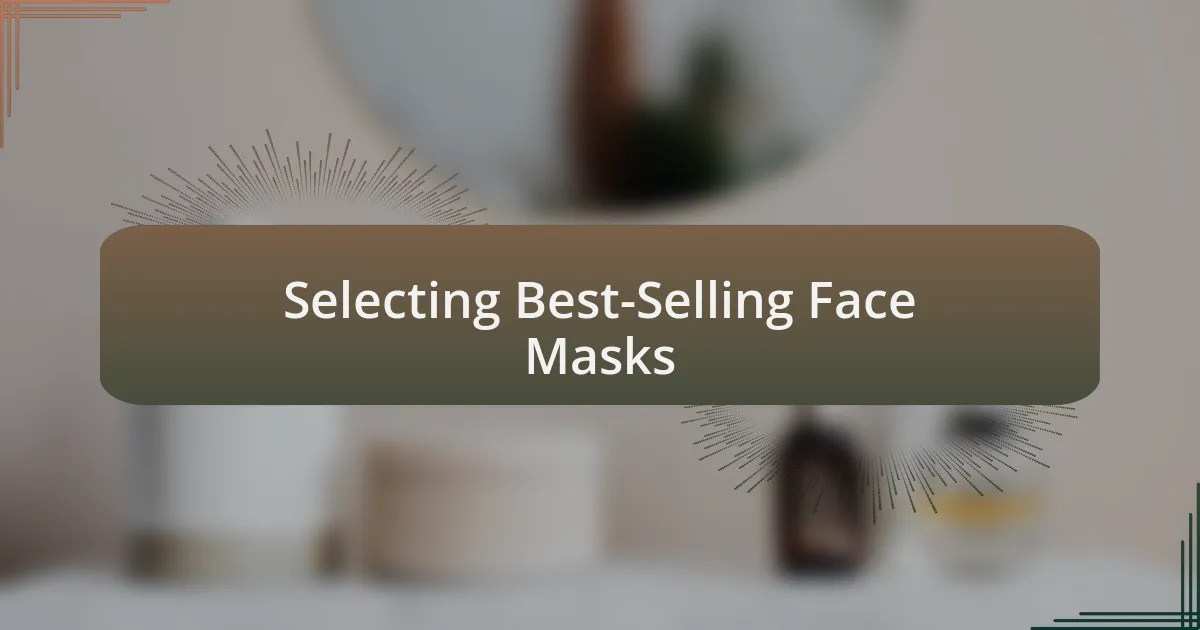Key takeaways:
- The face masks market is influenced by emotional well-being and community connections, with social media shaping consumer choices.
- Trends include a focus on sustainability, clean beauty, and personalization through customizable masks that cater to individual skin needs.
- Key factors affecting sales include skin health awareness, pricing strategies, and seasonal product preferences.
- When shopping for masks, consider ingredients, customer reviews, and ensure compatibility with your skin type to avoid negative experiences.

Understanding Face Masks Market
The face masks market has evolved dramatically over recent years, largely due to increased consumer awareness about skin care. I remember a time when I purchased a face mask purely for its appealing packaging, only to realize the ingredients didn’t deliver results. It makes me wonder—how many others have had a similar experience? The market now is flooded with options, making it essential for consumers to prioritize their needs and understand what each product offers.
When we delve into the motivations behind purchases, it’s fascinating to see how emotional well-being plays a crucial role. Masks are not just about skincare; they often serve as a moment of self-care amidst busy lives. Personally, I find that indulging in a face mask can transform a hectic day into a mini-spa retreat, making me more inclined to explore new products.
Furthermore, the rise of social media has created an overwhelming influence on the face masks market, with countless reviews and trends shaping consumer choices. I often catch myself checking reviews before trying a new mask and pondering—how does this community trust affect our buying decisions? Clearly, the face masks we choose are as much about community connection as they are about personal benefit.

Trends in Face Masks
The latest trend in face masks has shifted towards sustainability and clean beauty, reflecting a broader consumer demand for eco-friendly products. I remember feeling a wave of satisfaction when I discovered a brand that not only prioritized natural ingredients but also used recyclable packaging. It’s a reminder that we can indulge in self-care while being mindful of our planet—how often do we get to feel good about both?
Moreover, personalization has emerged as a game-changer. Customizable face mask kits allow individuals to tailor treatments to their specific skin concerns, making the experience feel more intimate and effective. I once crafted a mask specifically for hydration and found it not only addressed my skin’s needs but also made me feel empowered in my skincare choices. Isn’t it incredible how we can now curate our beauty routines to align with our unique identities?
Social media continues to play a pivotal role in showcasing new innovations and trends in face masks. Many influencers share their favorite products, often paired with stunning visuals and genuine reviews. I can’t help but recall the excitement I felt after trying a mask recommended by a trusted source, as it made me feel connected to a larger community. This dynamic interaction transforms the way we view skincare—it’s less about mere products and more about shared experiences.

Factors Influencing Face Mask Sales
Several factors significantly influence face mask sales in today’s market, and understanding them can provide valuable insights. For instance, the rise in awareness surrounding skin health has increased demand for targeted treatments. I vividly remember the moment I realized just how much a face mask could rejuvenate my skin, making me more likely to seek out similar products. Could it be that more consumers are having these “aha” moments too?
Pricing strategies play a crucial role in the purchasing decision as well. When I found a high-quality mask at a price that didn’t break the bank, it felt like striking gold. It made me wonder—how often do we hesitate to buy a product because it seems just a tad too pricey? Offering effective products at accessible prices can significantly drive sales.
Seasonal trends also affect face mask sales, as consumers often switch to different products to meet their changing skin needs throughout the year. I recall the rush I felt during winter when hydrating masks became my go-to for combating dry skin. Isn’t it fascinating how our skin’s requirements can mirror the seasons, prompting shifts in buying behavior? Recognizing these patterns can help brands tailor their offerings to meet consumer expectations effectively.

Selecting Best-Selling Face Masks
When selecting best-selling face masks, I often start by considering the ingredients. For example, I once discovered a mask that contained hyaluronic acid and, after just one use, my skin felt plump and hydrated. Isn’t it amazing how the right ingredients can transform our skin? I think many of us seek products that promise such results.
Another key factor for me is customer reviews. I remember browsing product listings and coming across a mask that had hundreds of glowing reviews. The insights from fellow users often resonate with my own experiences, making me more confident in my purchase. Do you also find that a few positive testimonials can sway your decision?
Lastly, packaging matters more than I initially thought. When I first encountered a beautifully designed mask, I was drawn to it not just for its aesthetic but for the feeling of luxury it conveyed. It reminded me that sometimes, the presentation can elevate the entire experience. Could it be that we often underestimate the power of visual appeal?

Recommendations for Face Mask Shoppers
When shopping for face masks, I always consider my skin type. For instance, I remember a time when I bought a mask without checking if it was suitable for my sensitive skin. After just one use, my face was red and irritated, reminding me how crucial it is to choose products matched to our unique skin needs. Do you check labels carefully to avoid similar mishaps?
Another aspect I pay attention to is the fragrance. I vividly recall using a mask that was heavily scented, which, while initially pleasant, became overwhelming during the application. A strong scent can alter the overall spa-like experience we seek. Have you ever experienced a lovely product ruined by an overpowering fragrance?
I also advise trying sample sizes before committing to a full-size product. I remember splurging on a high-end mask, only to find it didn’t provide the promised results for my skin. Sampling can prevent wasted money and disappointment. How often do you take advantage of samples to test before you buy?